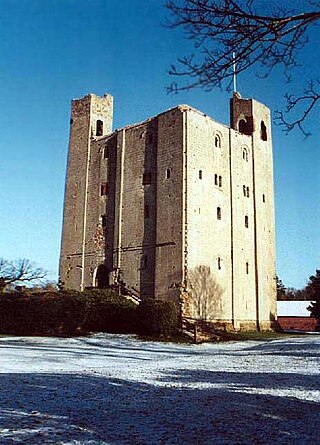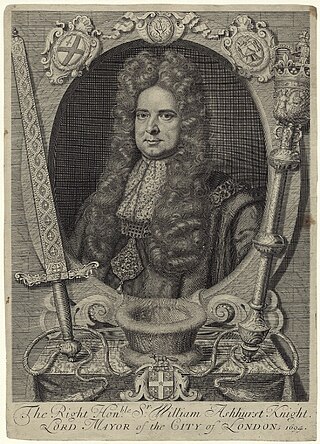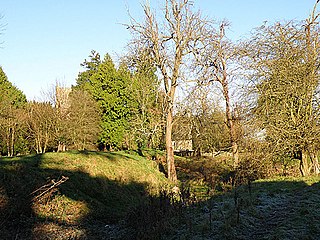
Earl of Oxford is a dormant title in the Peerage of England, first created for Aubrey de Vere by the Empress Matilda in 1141. His family was to hold the title for more than five and a half centuries, until the death of the 20th Earl in 1703. The de Veres were also hereditary holders of the office of Master Chamberlain of England from 1133 until the death of the 18th Earl in 1625. Their primary seat was Hedingham Castle in Essex, but they held lands in southern England and the Midlands, particularly in eastern England. The actual earldom was called "Oxenford" until at least the end of the 17th century. Medieval sources thus refer to "my lord of Oxenford" when speaking of the earl.
John de Vere, 13th Earl of Oxford, the second son of John de Vere, 12th Earl of Oxford, and Elizabeth Howard, a first cousin of John Howard, 1st Duke of Norfolk, was one of the principal Lancastrian commanders during the English Wars of the Roses.

Castle Hedingham is a village in northern Essex, England, located four miles west of Halstead and 3 miles southeast of Great Yeldham in the Colne Valley on the ancient road from Colchester, Essex, to Cambridge.
Aubrey de Vere — also known as "Alberic[us] de Ver" and "Albericus regis camerarius" — was the second of that name in England after the Norman Conquest, being the eldest surviving son of Aubrey de Vere and his wife Beatrice.

Aubrey de Vere, 1st Earl of Oxford was an English noble involved in the succession conflict between King Stephen and Empress Matilda in the mid-twelfth century.
John de Vere, 12th Earl of Oxford, was the son of Richard de Vere, 11th Earl of Oxford, and his second wife, Alice Sergeaux (1386–1452). A Lancastrian loyalist during the latter part of his life, he was convicted of high treason and executed on Tower Hill on 26 February 1462.

Ashton Keynes Castle was a castle in the village of Ashton Keynes, near to the town of Cricklade in Wiltshire, England. It is also known as Hall's Close, while locals call it The Battlefield. The scheduled monument consists of a ringwork and bailey 100 metres (330 ft) west of Kentend Farm.

Great Canfield Castle lies in the small village of Great Canfield, 3 miles (5 km) south-west of Great Dunmow in Essex, England: grid reference TL595179.
Agnes of Essex, Countess of Oxford was the daughter of a royal constable Henry of Essex and his first Cecily. At the age of three she was betrothed to Geoffrey de Vere, brother of the first Earl of Oxford, and turned over to be raised by the Veres soon thereafter. She remained in the household of the earl of Oxford about three years, then moved to Geoffrey's care. In her eleventh year Agnes rejected the match with Geoffrey and by early 1163 was married to his eldest brother Aubrey de Vere III, 1st Earl of Oxford, as his third wife.
Colne Priory at Earls Colne, Essex was a Benedictine priory, initially a dependent cell of Abingdon Abbey, Berkshire. It was founded by Aubrey de Vere I and his wife Beatrice in or before 1111. One piece of research suggests that the original Abbot, Faritius, was appointed in 1101; he initially placed six monks at the site. Their eldest son Geoffrey had died at Abingdon about seven or eight years earlier and was buried there. On his deathbed, Geoffrey had bequeathed to Abingdon the church and lands at Kensington, Middlesex, and his parents and brothers had confirmed that grant, as had King Henry I.

Robert de Vere, hereditary Master Chamberlain of England, was the son of Aubrey de Vere, 1st Earl of Oxford, and Agnes of Essex. He succeeded his brother as the third Earl of Oxford, and was one of the twenty-five guarantors of Magna Carta.

Hugh de Vere, 4th Earl of Oxford was the only son and heir of Robert de Vere, 3rd Earl of Oxford and Isabel de Bolebec, daughter and eventually sole heiress of Hugh de Bolebec.

Elizabeth de Vere, Countess of Oxford was an English noblewoman. As a young child she became a royal ward.
Aubrey (Albericus) de Vere was a tenant-in-chief in England of William the Conqueror in 1086, as well as a tenant of Geoffrey de Montbray, bishop of Coutances and of Count Alan, lord of Richmond. A much later source named his father as Alphonsus.

Sir William Ashhurst was an English banker, merchant and Whig politician who sat in the English and British House of Commons from 1689 to 1710. He also served as the Lord Mayor of London in 1693.
Lewis Ashurst Majendie was a British Conservative Party politician.

English Bicknor Castle was a castle in the village of English Bicknor in Gloucestershire, England.

The House of de Vere was an old and powerful English aristocratic family who derived their name from Ver, in Lower Normandy, France.

Musette Frances Jacqueline Natalie Majendie CBE (1903–1981) was the owner of Hedingham Castle. In 1713 the castle was purchased by Sir William Ashhurst. After his death in 1720, the estate passed to his great granddaughter, the wife of Lewis Majendie. The Majendie family owned Hedingham Castle for 250 years until Miss Majendie left it to her cousin Thomas Lindsay.











